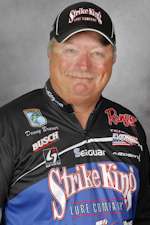Last time we talked about the flat side of the lake and about the importance of baitfish and forage. That was good then, but as fall moves towards winter and everything starts to get colder, the bass tend to move more towards the vertical stuff. You need to move with them.
Depending upon what part of the country you’re in, this will happen when the water drops to anywhere between 45 and 60 degrees. Chunk rock banks, riprap and bluff ends are all good places to start. Whether you flip, pitch or cast at this time of the year depends to a great extent on water conditions.
If the water is clear, it can be hard to flip and pitch. Lots of times the bite will move down to 10 or 15 feet. That’s not my idea of a good flipping or pitching scenario. It’s usually more efficient to cast under those circumstances. If the water has some color to it, however, flipping and pitching is often the best way to fish those areas. It gives you precise coverage and better bait control.
Another situation where you’ll want your flipping and pitching stick in your hand is when you can find boat docks with brushpiles on them. Again, you’re looking for those docks that are on the steep banks near chunk rock or around bluff walls.
But the best flipping and pitching opportunities are on the mats. As fall turns into early winter, the bass move under the mats, and they’re still feeding. How long this lasts will depend upon what part of the country you’re in.
In Florida and much of the Deep South, opportunities under the mats will go from early fall all the way to early spring. In fact, that’s often the prevailing pattern in that area of the country, especially if you’re looking for big fish. As you move farther north things change.
Really cold water will kill what little grass is left in the mats and cause them to sink or to start sinking. They’re not very good when that’s happening. I think it probably has something to do with the oxygen that’s available. Whatever the reason, though, avoid dead, sinking mats. They do not produce.
By now the bass are pretty much fed up. They aren’t eating like they did a couple of weeks ago. This is not a time when you’ll want to key on the shad bite. I usually do better with crawfish-type presentations. But you still have to be aware of what’s happening. Pay attention to what’s going on in your lake. The fish are always going to be where the food’s at. Keep that in mind, just don’t take it to extremes.
My lure choice for the fall to winter period starts with a 1/2-ounce Strike King Premier Pro-Model jig with a 3X chunk behind it. The important thing here is not to have too much action. You want a more subtle presentation.
The water’s usually clear at this time of the year so I go with a natural-looking color, Number 46, for my jig. Green pumpkin complements it really well for my chunk. If the water’s stained, I’ll switch to black and blue.
I mix it up when I’m crashing mats. If I’m in Florida, I might go with green pumpkin, red shad or black neon. As I move north, I’ll lean more towards black and blue as my primary choice. If you’re looking for an all-around color, I’d have to say it’s black and blue.
When I’m crashing mats, I like to Texas rig a Strike King Rodent, Rage Craw or one of our new Shellcrackers. You want something that’s fairly compact and not too long. My hook is the new Mustad Grip-Pin Max. It has a peg that’ll hold the plastic bait in place. That’s important because when your bait rips through a mat it has a tendency to slide down the shank of the hook.
I use 25-pound-test Seaguar Tatsu fluorocarbon line with all these techniques, with one exception. If I’m strictly flipping mats, I go with 60-pound-test braid Seaguar Kanzen. It cuts through the vegetation a little easier, and it’s dark under the mat so it’s not like they can see your line.
Next time we’ll talk about catching them when the water turns cold.





